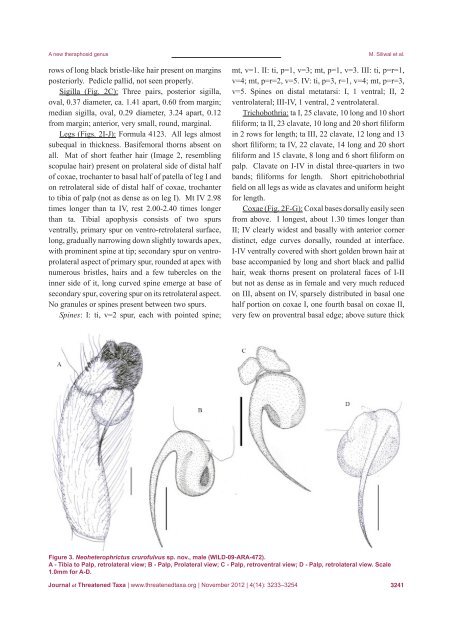View - Journal of Threatened Taxa
View - Journal of Threatened Taxa
View - Journal of Threatened Taxa
You also want an ePaper? Increase the reach of your titles
YUMPU automatically turns print PDFs into web optimized ePapers that Google loves.
A new theraphosid genusrows <strong>of</strong> long black bristle-like hair present on marginsposteriorly. Pedicle pallid, not seen properly.Sigilla (Fig. 2C): Three pairs, posterior sigilla,oval, 0.37 diameter, ca. 1.41 apart, 0.60 from margin;median sigilla, oval, 0.29 diameter, 3.24 apart, 0.12from margin; anterior, very small, round, marginal.Legs (Figs. 2I-J): Formula 4123. All legs almostsubequal in thickness. Basifemoral thorns absent onall. Mat <strong>of</strong> short feather hair (Image 2, resemblingscopulae hair) present on prolateral side <strong>of</strong> distal half<strong>of</strong> coxae, trochanter to basal half <strong>of</strong> patella <strong>of</strong> leg I andon retrolateral side <strong>of</strong> distal half <strong>of</strong> coxae, trochanterto tibia <strong>of</strong> palp (not as dense as on leg I). Mt IV 2.98times longer than ta IV, rest 2.00-2.40 times longerthan ta. Tibial apophysis consists <strong>of</strong> two spursventrally, primary spur on ventro-retrolateral surface,long, gradually narrowing down slightly towards apex,with prominent spine at tip; secondary spur on ventroprolateralaspect <strong>of</strong> primary spur, rounded at apex withnumerous bristles, hairs and a few tubercles on theinner side <strong>of</strong> it, long curved spine emerge at base <strong>of</strong>secondary spur, covering spur on its retrolateral aspect.No granules or spines present between two spurs.Spines: I: ti, v=2 spur, each with pointed spine;M. Siliwal et al.mt, v=1. II: ti, p=1, v=3; mt, p=1, v=3. III: ti, p=r=1,v=4; mt, p=r=2, v=5. IV: ti, p=3, r=1, v=4; mt, p=r=3,v=5. Spines on distal metatarsi: I, 1 ventral; II, 2ventrolateral; III-IV, 1 ventral, 2 ventrolateral.Trichobothria: ta I, 25 clavate, 10 long and 10 shortfiliform; ta II, 23 clavate, 10 long and 20 short filiformin 2 rows for length; ta III, 22 clavate, 12 long and 13short filiform; ta IV, 22 clavate, 14 long and 20 shortfiliform and 15 clavate, 8 long and 6 short filiform onpalp. Clavate on I-IV in distal three-quarters in twobands; filiforms for length. Short epitrichobothrialfield on all legs as wide as clavates and uniform heightfor length.Coxae (Fig. 2F-G): Coxal bases dorsally easily seenfrom above. I longest, about 1.30 times longer thanII; IV clearly widest and basally with anterior cornerdistinct, edge curves dorsally, rounded at interface.I-IV ventrally covered with short golden brown hair atbase accompanied by long and short black and pallidhair, weak thorns present on prolateral faces <strong>of</strong> I-IIbut not as dense as in female and very much reducedon III, absent on IV, sparsely distributed in basal onehalf portion on coxae I, one fourth basal on coxae II,very few on proventral basal edge; above suture thickFigure 3. Neoheterophrictus crur<strong>of</strong>ulvus sp. nov., male (WILD-09-ARA-472).A - Tibia to Palp, retrolateral view; B - Palp, Prolateral view; C - Palp, retroventral view; D - Palp, retrolateral view. Scale1.0mm for A-D.<strong>Journal</strong> <strong>of</strong> <strong>Threatened</strong> <strong>Taxa</strong> | www.threatenedtaxa.org | November 2012 | 4(14): 3233–32543241

















